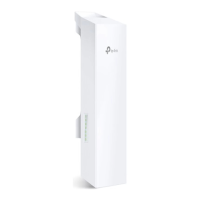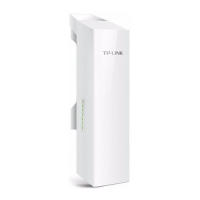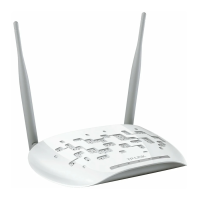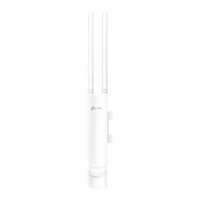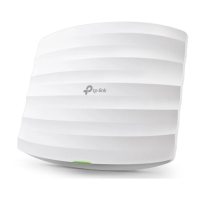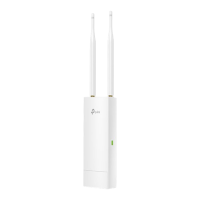Do you have a question about the TP-Link CPE210 and is the answer not in the manual?
Details the meaning of each LED light on the Pharos CPE, using CPE220 as an example.
Illustrates the physical ports and buttons on the CPE220 and CPE210/CPE510 models.
Explains the function and components of the Passive PoE adapter included with the CPE.
Demonstrates a typical point-to-point wireless network setup using the CPE device.
Guidance on choosing an optimal mounting height and orientation for performance.
Steps for connecting the CPE to the power adapter and network devices.
Methods for proper grounding to protect the device from electrical surges.
Instructions on assigning a static IP and accessing the device's web interface.
Guides for configuring the device as an Access Point or Client in a wireless bridge setup.
Instructions on resetting the CPE using the device button or the PoE adapter's remote reset.
Explains the Fresnel Zone method for determining optimal device placement height.
Details the proprietary TDMA-based protocol and its advantages for wireless performance.
Guide on using the Spectrum Analysis tool to find the optimal wireless channel.
Details the meaning of each LED light on the Pharos CPE, using CPE220 as an example.
Illustrates the physical ports and buttons on the CPE220 and CPE210/CPE510 models.
Explains the function and components of the Passive PoE adapter included with the CPE.
Demonstrates a typical point-to-point wireless network setup using the CPE device.
Guidance on choosing an optimal mounting height and orientation for performance.
Steps for connecting the CPE to the power adapter and network devices.
Methods for proper grounding to protect the device from electrical surges.
Instructions on assigning a static IP and accessing the device's web interface.
Guides for configuring the device as an Access Point or Client in a wireless bridge setup.
Instructions on resetting the CPE using the device button or the PoE adapter's remote reset.
Explains the Fresnel Zone method for determining optimal device placement height.
Details the proprietary TDMA-based protocol and its advantages for wireless performance.
Guide on using the Spectrum Analysis tool to find the optimal wireless channel.
| 5 GHz | No |
|---|---|
| Bandwidth | 2.4 GHz |
| Modulation | - |
| Frequency band | 2.4 - 2.483 GHz |
| Number of users | - user(s) |
| Channels quantity | - channels |
| Networking standards | IEEE 802.11b, IEEE 802.11g, IEEE 802.11n |
| Receiver sensitivity | 802.11b:\\r 11M: -95dBm, 5.5M: -96dBm, 2M: -96dBm, 1M: -96dBm\\r -802.11g:\\r 54M: -79dBm, 48M: -80dBm, 36M: -84dBm, 6-24M: -88dBm\\r 802.11n:\\r MCS15: -76dBm, MCS14: -78dBm, MCS13: -80dBm, \\r MCS12: -84dBm, MCS11: -87dBm, MCS10: -91dBm, \\r MCS9: -93dBm, MCS8: -96dBm, MCS7: -76dBm, \\r MCS6: -78dBm, MCS5: -80dBm, MCS4: -84dBm, \\r MCS3: -87dBm, MCS2: -91dBm, MCS1: -93dBm, MCS0: -96dBm |
| Virtual LAN features | Tagged VLAN |
| Maximum outdoor range | 5000 m |
| Maximum data transfer rate | 300 Mbit/s |
| Management platform | Pharos Control |
| Flash memory | 8 MB |
| Internal memory | 64 MB |
| Processor model | Qualcomm Atheros |
| Processor frequency | 560 MHz |
| Compatible operating systems | Microsoft Windows 98SE, NT, 2000, XP, Vista or Windows 8, Windows 7, MAC OS, NetWare, UNIX or Linux. |
| Placement | Wall |
| Certification | - FCC/UL/IC/GS/PSB/C-tick/SAA/S-Mark/KC-mark\\r - RoHS, IPX5 |
| Product color | White |
| International Protection (IP) code | IPX5 |
| Security algorithms | SSID, TKIP, WPA, WPA-PSK, WPA2, WPA2-PSK |
| Antenna features | Integrated antenna |
| Antennas quantity | 1 |
| Antenna gain level (max) | 9 dBi |
| DC voltage range | 16 - 27 V |
| Power consumption (max) | 10.5 W |
| Storage temperature (T-T) | -40 - 70 °C |
| Operating temperature (T-T) | -30 - 70 °C |
| Storage relative humidity (H-H) | 5 - 95 % |
| Operating relative humidity (H-H) | 10 - 90 % |
| Cables included | AC |
| Transmit power range | 0 - 27 dBmW |
| WAN connection | Ethernet (RJ-45) |
| USB 2.0 ports quantity | 0 |
| Package depth | 132 mm |
| Package width | 270 mm |
| Package height | 106 mm |
| Harmonized System (HS) code | 85176990 |
| Depth | 79 mm |
|---|---|
| Width | 224.4 mm |
| Height | 60.3 mm |
